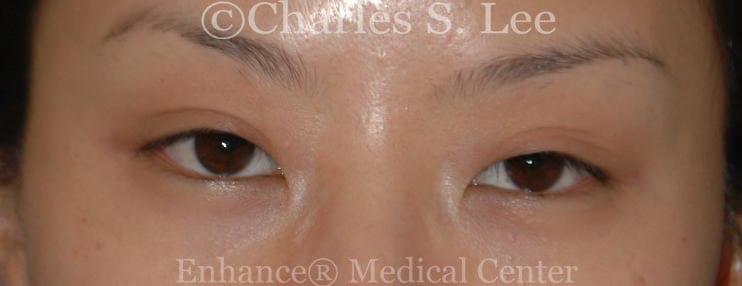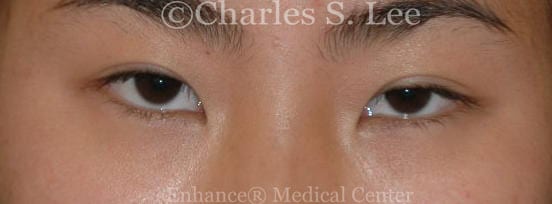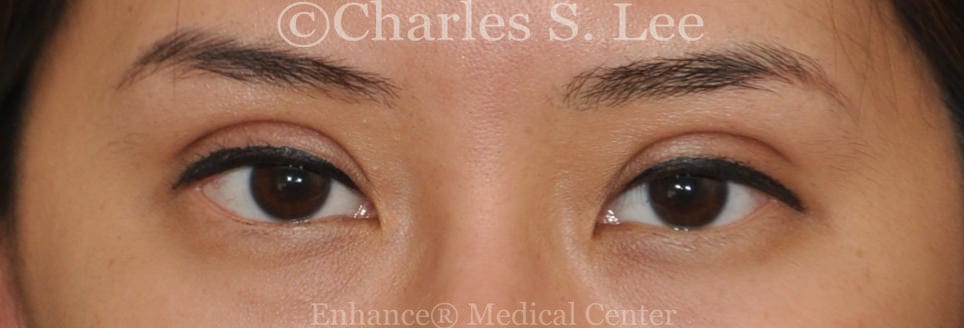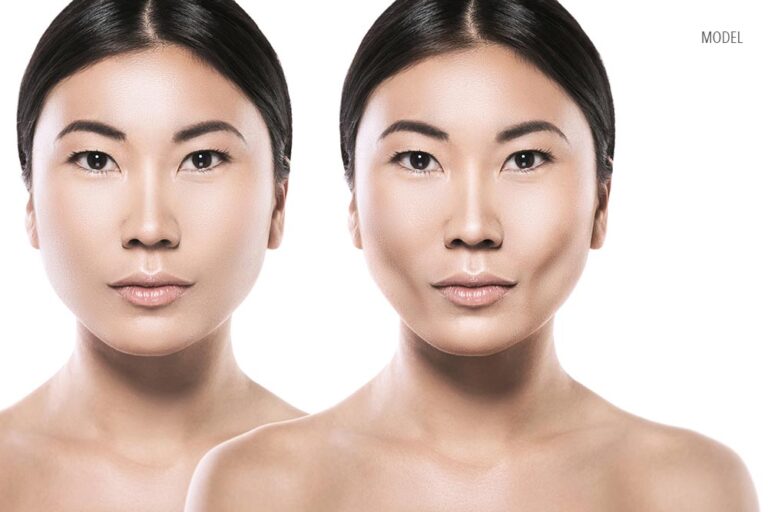All Asian double eyelid incision surgeries are not the same.
Every surgeon has his/her preferred technique. In the case of Asian double eyelid surgery, I prefer a technique called the “Anchor” procedure. This technique is in contrast to the more commonly performed “classical” technique.
In the classic technique, after the surgeon marks a crease at the proposed height and shape, the skin in incised to reach the levator (“lifting”) muscle and attaching the skin to this muscle. The area below the crease is typically left undisturbed. The advantage of this type of procedure is the quicker recovery time due to the less invasive nature of the operation.
There are several shortcomings to this classic technique.
1. Small preexisting folds are not corrected.
Because the area below the incision is not altered, any small preexisting folds will remain (picture below).
2. A symmetric result is more difficult to obtain.
In the classic technique, the skin is fixed to a dynamic structure, the levator aponeurosis, which is the mobile structure responsible for lifting the eyelid. As you can imagine, each eyelid crease has a higher probability of asymmetry when each eyelid crease is being secured to a dynamic structure.
A more symmetric result can be obtained if the fold is placed to a firm, immobile structure that can be measured precisely with a ruler measured in fractions of a millimeter. The ideal static structure for securing the crease is the cartilage that gives support to the eyelid along the lower margin (the “tarsal plate”). This structure also lies below the level of the crease and is not easily accessible if the surgery is limited to the area above the incision.
Note the preexisting fold and mild drooping of the eyelid, with the patient’s left eye more droopy than the right eye. One month after anchor eyelid surgery, the prior crease is removed and the fold is made more symmetric. At six months, the fold is expected to be about 20{0fd4121d5216b280473771676d11ae34909381d9377f36f96353e02149c70f16} smaller.
3. Loss of the crease can occur on occasion even with an incision technique.
In the classic technique, the crease is created by placing a suture from the skin edge to the underlying dynamic structure (levator aponeurosis), which results in a limited surface area to which the skin crease can stick down. Sometimes permanent nylon sutures are used to secure the skin. This can sometimes create a “tugging” sensation that patients find unsettling. In other cases, absorbable sutures are used to hold the skin long enough for scar formation to occur, which then yields a crease. However, because the area of dissection is limited, the “sticky” area of scar formation is also limited. The results is a less secure fold than if a larger “sticky” surface area is used to form the fold. This larger sticky surface area is, again, the cartilaginous “tarsal plate”, which is an area avoided in the classic technique.



Patients at higher risk for fold failure include those with very deep set eyes, large surgical size double eyelid fold, prominent medial epicanthal fold and thick eyelid skin.
4. Difficulty in converting suture technique to an incision technique.
As patients get older and there is more skin sag, many patients who were satisfied with their prior suture procedure request an open procedure to remove the sagging skin and excess fat. In other cases, weakness in the levator muscle requires conversion to an open technique to correct the drooping eyelid. Patients who have had the modern suture method asian double eyelid surgery such as the double suture and twisting (DST) technique or their variants (popular in Asia) requesting conversion to an incision technique will require surgical treatment in the sub-crease/ or tarsal area that is not treated by the classic technique. Surgeons not familiar with surgery in this area will frequently refuse surgery on these patients.


Flowers’ Anchor blepharoplasty.
The “anchor” incision surgery is an advance Asian eyelid technique developed by eyelid expert plastic surgeon Robert Flowers to address the shortcomings of the classical technique. As can be surmised, the anchor technique focuses on surgery in the area below the incision (in front of the tarsal plate). The advantages of the anchor technique include 1). Higher probability of a symmetric result, due to fixation of the crease to a static, unmoving cartilage structure rather than a moving, dynamic structure; 2) creation of a smooth, wrinkle free area below the surgical crease by removing any preexisting multiple smaller creases; 3) Lower probability of crease failure after surgery due to the larger “sticky” surface area to which the fold can adhere; and 4) maximum flexibility in corrective surgeries such as conversion of suture techniques to an incision technique.







